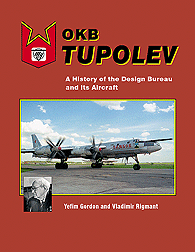|
Specialty Press |
|
OKB Tupolev A History of the Design Bureau and Its Aircraft |
|
by Yelim Gordon and Vladimir Rigmant |
|
Reviewed By Brian R. Baker, #43146 |
|
|
|
MSRP $59.95 USD ISBN # 1-85780-214-4 Ever since the dissolution of the Soviet Union and the independence of the various former Soviet republics, the availability of reliable information from regional authors has improved markedly, and this book is an example of this trend. Shrouded in secrecy for many years, the development of Soviet airpower has been an enigma in the West, and much misinformation has appeared in print, either intentionally or due to unavailability of source materials. Now, with the “security” paranoia gone, Russian authors have been able to delve into the archives and come up with much more accurate information about the development of aircraft and other weapons systems. The freedom to publish historical material has resulted in a number of really excellent works on Soviet aviation history, or which this title is one. Yelim Gordon is a well-known Russian aviation historian who lives in Moscow. He is fast developing the reputation be being the William Green of Russian aviation history, and he has published a number of works on Soviet aviation. Vladimir G. Rigmant is well qualified to assist in the writing of this text, having been employed since 1963 in the Soviet aviation industry, and since 1986, in the Tupolev Design Bureau in the firm’s operational support department. He is currently the company president’s press aide, and is also the director of the company’s aviation museum. Thus, the authors have had access to company files, photographs, and personnel who can give first hand accounts. The book begins with a ten page history of the Tupolev design Bureau from the earliest days during the Tsarist Regime through the Communist Revolution and the subsequent development of the Soviet system in the twenties and thirties. Originally, a design team headed by A. A. Tupolev, identified as TsAGI was established in 1922, although its roots went back to 1918. Many other designers and engineers worked with Tupolev at various times, persons who would eventually make their mark on Soviet aeronautical development. These included A.A. Arkhangel’skiy, Vladimir Petlyakov, Pavel O. Sukhoi, and Vladimir M. Myasishchev, and others too numerous to mention, some of whom eventually headed their own design bureaus and became famous on their own. The introductory section of the book is divided into eight distinct developmental phases, which are described as follows: 1. 1918-1925 Formation of TsAGI and early metal aircraft development. 2. 1925-1932 All metal aircraft production, including civil and military aircraft. 3. 1933-1937 First large aircraft developed, smooth skin developments. Stalin’s purges, imprisonment of designers, breakup of design teams. 4. 1938-1945 Development of Special Technical Department of the NKVD, re-establishment of Tupolev Design Bureau, Outbreak of world war II, called Great Patriotic War by Soviets. Wartime designs. 5. 1945-1955 Postwar and Cold War expansion. TU-4 (B-29 copy) development. 6. 1955-1972 Growth, Expansion of experimental work, computer design. Turbine powered aircraft. Jet airliners. 7. 1972-1990 Tupolev died, and was replaced by his son Aleksey Tupolev. New aircraft and missile developments. 8. 1990-Date Radical political changes. Firm changes emphasis from military to civil aircraft development. Advanced projects. Firm changes from state owned enterprise to joint-stock corporation. Aleksey Tupolev died in 2001. New management. All of this is in a brief introduction. The real content of the book, however, deals with the development of individual aircraft, many of which are unknown to Western readers. Beginning with the single seat ANT-1 (ANT designations were A. N. Tupolev’s initials) sport plane of composite construction, the text outlines in detail the development of major and minor design projects, including those which were never built even in prototype form. Some of the earlier types included the ANT-3 (R-3) all metal reconnaissance biplane, the ANT-4 (TB-1) twin engine bomber, the ANT-5 (I-4) all metal biplane fighter, and the gigantic ANT-6 (TB-3) four engine bomber. Excellent photos, mostly unpublished in the West, are included, and the three views are very informative. I feel that the book will be very useful for modelers interested in building models of some of the Russian aircraft that are starting to emerge from Russia and the Ukraine. The Tupolev group developed an astonishing variety of aircraft, including fighters, bombers, reconnaissance, and transport types. One of the most famous was the ANT-40, which was produced during the thirties as the SB high speed bomber. This is covered in great detail, with some explanation of the various production variations that were built. It doesn’t provide the detail given in Maslov’s Tupolev SB Soviet High Speed Bomber reviewed previously on this IPMS website, but does give an excellent coverage of the basic history of the type. This book describes every aircraft produced or designed by the Tupolev organization, including missile systems. It is very complete, and will take the enthusiast a long time to read through the fascinating content. One very interesting feature of this book is the 76 color photos included at the end, including those of some surprising surviving examples of early Soviet aircraft. In addition, 600 black and white photos are included, plus many line drawings. The real value of this book is that it just seems to go on and on, describing one type or project after another, aircraft that I was mostly unfamiliar with. Each type is covered with exacting detail, and for anyone interested in the development of Soviet and Russian aviation, this book is a “must have”. It is fascinating reading, and at the price, a bargain. I would recommend it highly. Thanks to Specialty Press for the review copy. The book can be ordered direct from the publishers at www.specialtypress.com for $59.95 USD, plus $4.95 shipping and handling. Their phone is 1-800-895-4585. |
|
Information, images, and all
other items placed electronically on this site |
